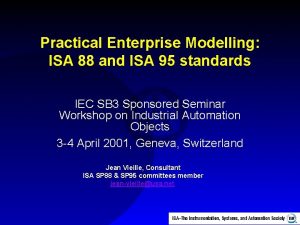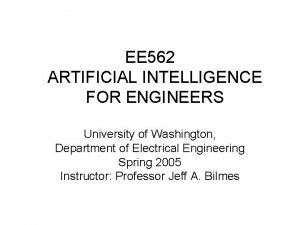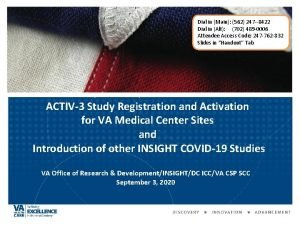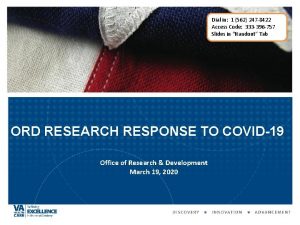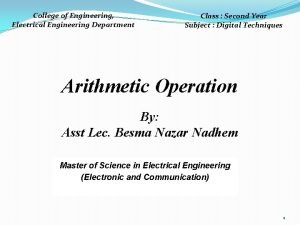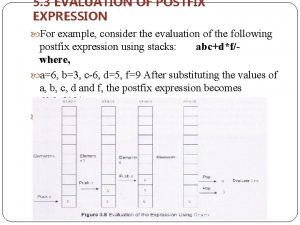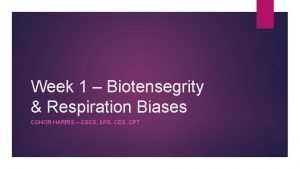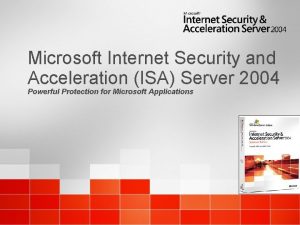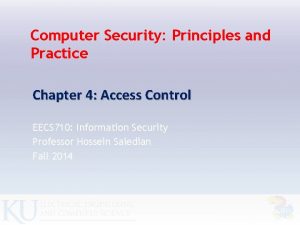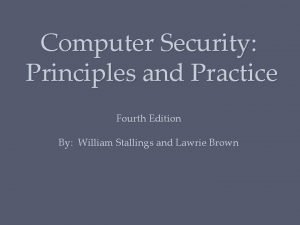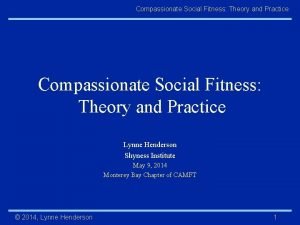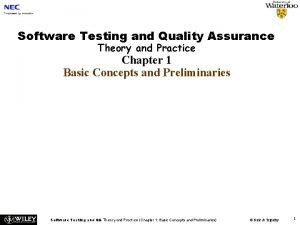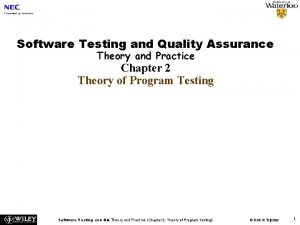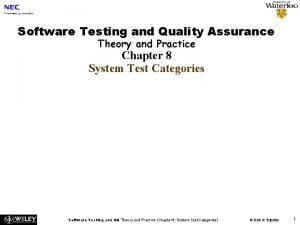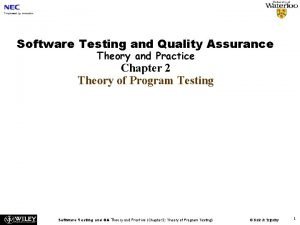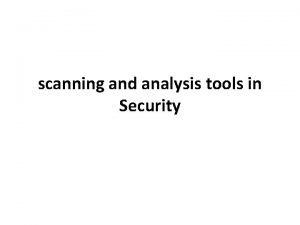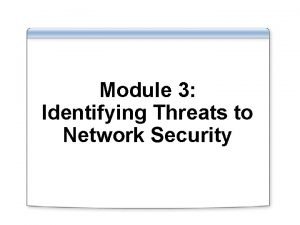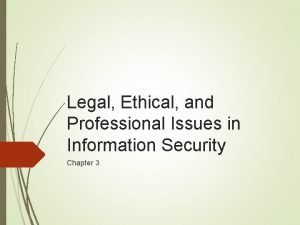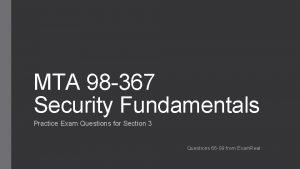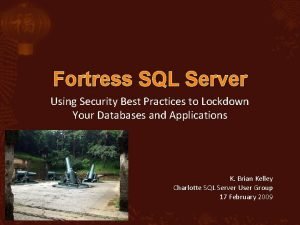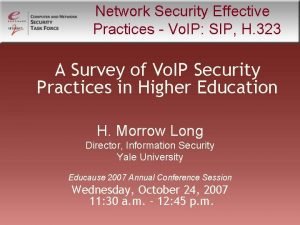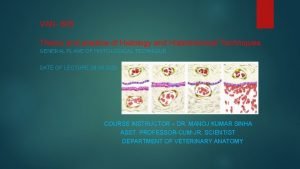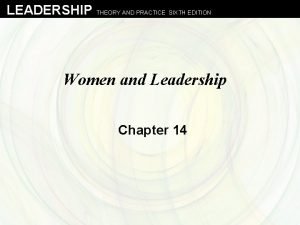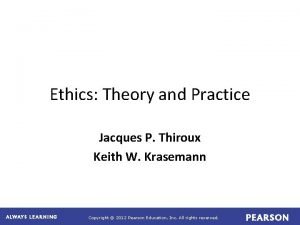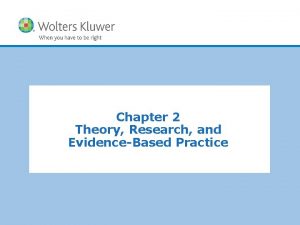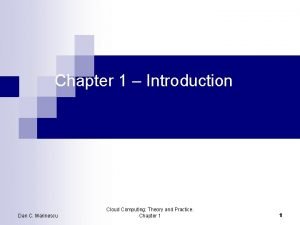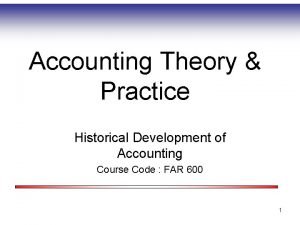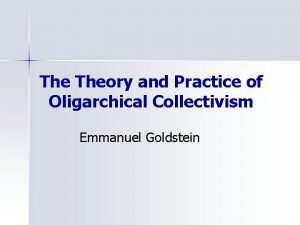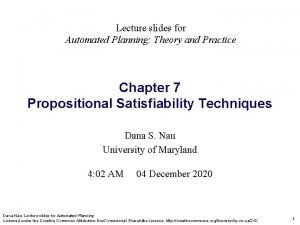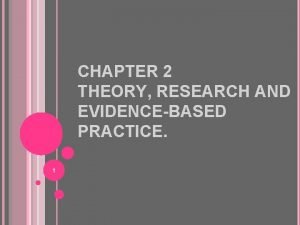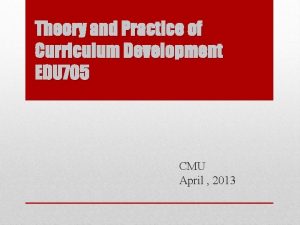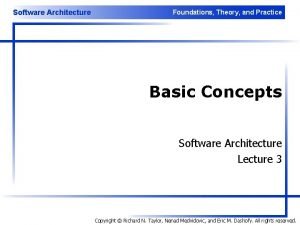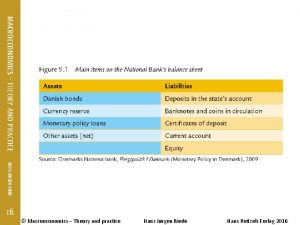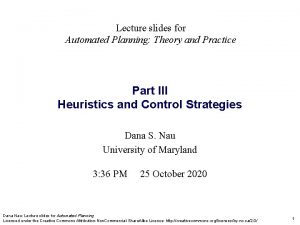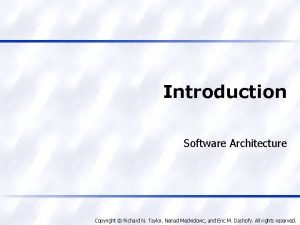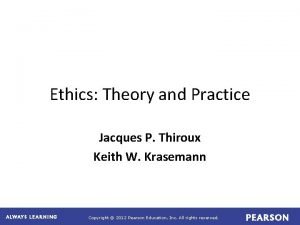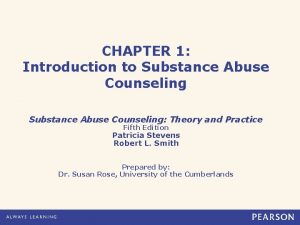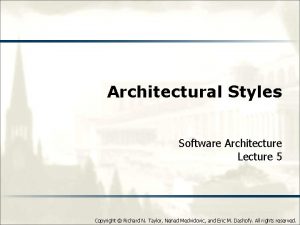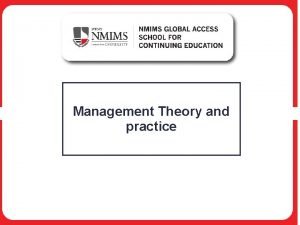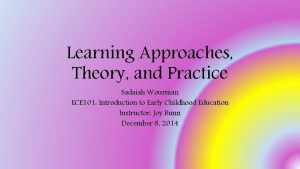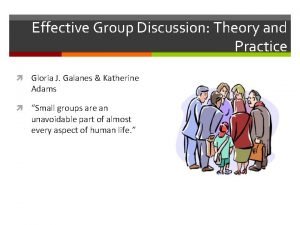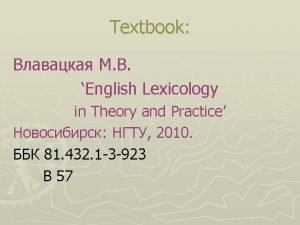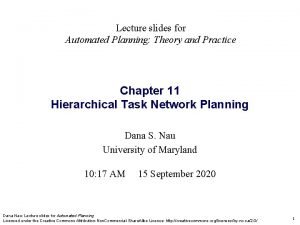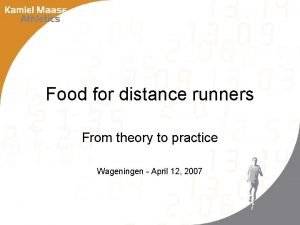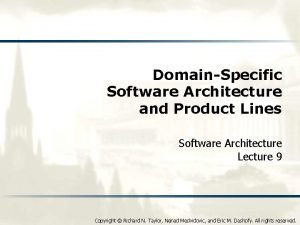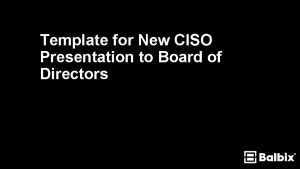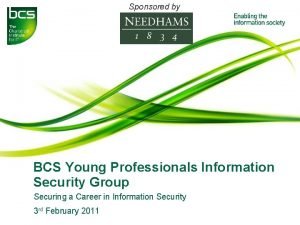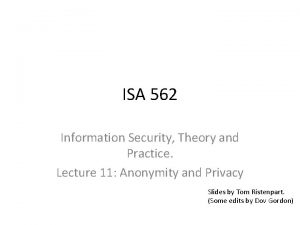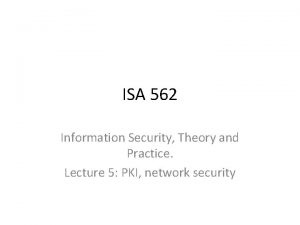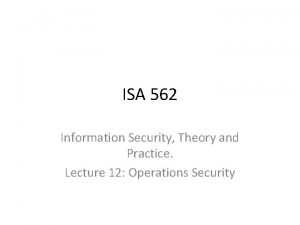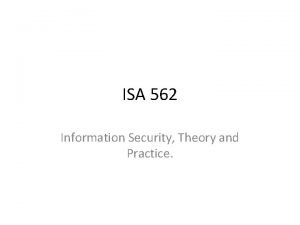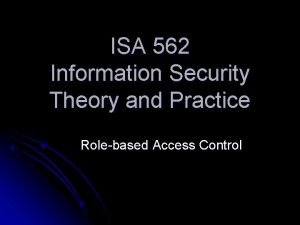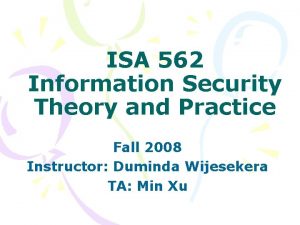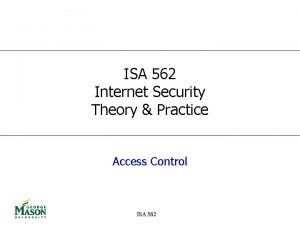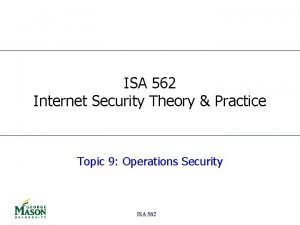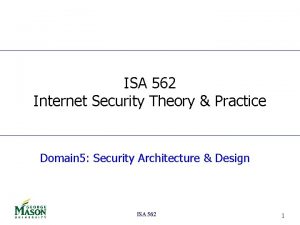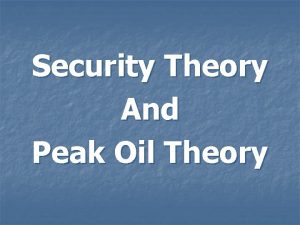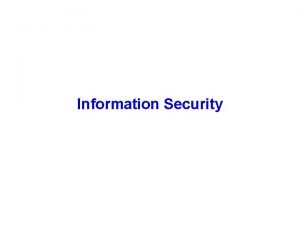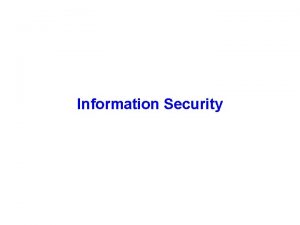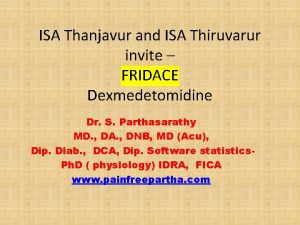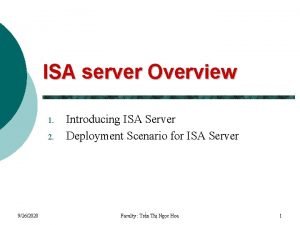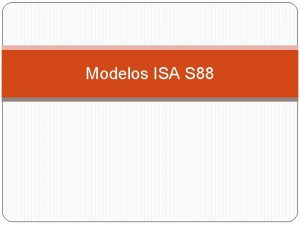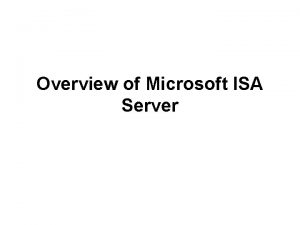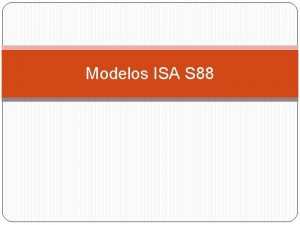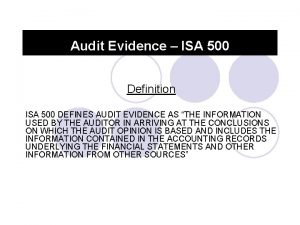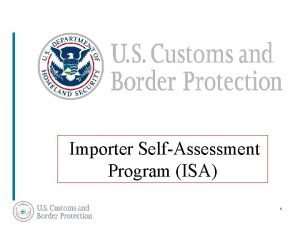ISA 562 Information Security Theory and Practice Lecture



















































































- Slides: 83

ISA 562 Information Security, Theory and Practice. Lecture 8: OS security Slides from Goodrich and Tamassia

Operating Systems Concepts 2

A Computer Model • An operating system has to deal with the fact that a computer is made up of a CPU, random access memory (RAM), input/output (I/O) devices, and long-term storage. I/O CPU 0 1 2 3 4 5 6 7 8 9. . . RAM Disk Drive 3

OS Concepts • An operating system (OS) provides the interface between the users of a computer and that computer’s hardware. – An operating system manages the ways applications access the resources in a computer, including its disk drives, CPU, main memory, input devices, output devices, and network interfaces. – An operating system manages multiple users. – An operating system manages multiple programs. 4

The Kernel • The kernel is the core component of the operating system. It handles the management of low-level hardware resources, including memory, processors, and input/output (I/O) devices, such as a keyboard, mouse, or video display. • Most operating systems define the tasks associated with the kernel in terms of a layer metaphor, with the hardware components, such as the CPU, memory, and input/output devices being on the bottom, and users and applications being on the top. User Applications Userland Non-essential OS Applications Operating System The OS Kernel CPU, Memory, Input/Output Hardware 5

Input/Output • The input/output devices of a computer include things like its keyboard, mouse, video display, and network card, as well as other more optional devices, like a scanner, Wi-Fi interface, video camera, USB ports, etc. • Each such device is represented in an operating system using a device driver, which encapsulates the details of how interaction with that device should be done. – The application programmer interface (API), which the device drivers present to application programs, allows those programs to interact with those devices at a fairly high level, while the operating system does the “heavy lifting” of performing the low-level interactions that make such devices actually work. 6

System Calls • User applications don’t communicate directly with low-level hardware components, and instead delegate such tasks to the kernel via system calls. • System calls are usually contained in a collection of programs, that is, a library such as the C library (libc), and they provide an interface that allows applications to use a predefined series of APIs that define the functions for communicating with the kernel. – Examples of system calls include those for performing file I/O (open, close, read, write) and running application programs (exec). 7

Processes • A process is an instance of a program that is currently executing. • The actual contents of all programs are initially stored in persistent storage, such as a hard drive. • In order to be executed, a program must be loaded into random-access memory (RAM) and uniquely identified as a process. • In this way, multiple copies of the same program can be run as different processes. – For example, we can have multiple copies of MS Powerpoint open at the same time. 8

Process IDs • Each process running on a given computer is identified by a unique nonnegative integer, called the process ID (PID). • Given the PID for a process, we can then associate its CPU time, memory usage, user ID (UID), program name, etc. 9

Multitasking • Give each running program a “slice” of the CPU’s time. • The CPU is running so fast that to any user it appears that the computer is running all the programs simultaneously. Public domain image from http: //commons. wikimedia. org/wiki/File: Chapters_meeting_2009_Liam_juggling. JPG 10

Process Tree • When a user starts a program, the OS sees this as a request by an existing process. E. g. a shell, or a GUI. • The new process is forked from the first, and becomes the child of the parent process. – The child inherits the permissions of the parent. • In Linux, the root of the process tree is init, which begins during the boot process. – Init forks processes for user logins. – It becomes the parent of “orphaned” processes whose parents have terminated. 11

Process Privileges • The OS associates a user with each running process. – These dictate which resources the process is allowed to access. • The process also inherits the permissions of the parent process. • In Unix-based OSes, also an effective UID. – Typically same as user ID, but can be set to be the ID of the application’s owner, which might have more privilege. 12

File Systems • A filesystem is an abstraction of how the external, nonvolatile memory of the computer is organized. • Operating systems typically organize files hierarchically into folders, also called directories. • Each folder may contain files and/or subfolders. • Thus, a volume, or drive, consists of a collection of nested folders that form a tree. • The topmost folder is the root of this tree and is also called the root folder. 13

File System Example 14

File Permissions • File permissions are checked by the operating system to determine if a file is readable, writable, or executable by a user or group of users. • In Unix-like OS’s, a file permission matrix shows who is allowed to do what to the file. – Files have owner permissions, which show what the owner can do, and group permissions, which show what some group id can do, and world permissions, which give default access rights. 15

Memory Management • The RAM memory of a computer is its address space. • It contains both the code for the running program, its input data, and its working memory. • For any running process, it is organized into different segments, which keep the different parts of the address space separate. • As we will discuss, security concerns require that we never mix up these different segments. 16

Memory Organization • Text. This segment contains the actual (binary) machine code of the program. • Data. This segment contains static program variables that have been initialized in the program code. • BSS. This segment, which is named for an antiquated acronym for block started by symbol, contains static variables that are uninitialized. • Heap. This segment, which is also known as the dynamic segment, stores data generated during the execution of a process. • Stack. This segment houses a stack data structure that grows downwards and is used for keeping track of the call structure of subroutines (e. g. , methods in Java and functions in C) and their arguments. 17

Memory Layout 18

Memory access permissions • Each of the 5 memory segments has its own set of permissions (read, write, execute). • Processes are not allowed to access the address space of other processes, unless explicitly granted permission. • The OS also broadly separates the memory into space for user applications, and space for the kernel. 19

Virtual Memory • There is generally not enough computer memory for the address spaces of all running processes. • Nevertheless, the OS gives each running process the illusion that it has access to its complete (contiguous) address space. • In reality, this view is virtual, in that the OS supports this view, but it is not really how the memory is organized. • Instead, memory is divided into pages, and the OS keeps track of which ones are in memory and which ones are stored out to disk. ATM 20

Page Faults 1. Process requests virtual address not in memory, causing a page fault. 2. Paging supervisor pages out an old block of RAM memory. “read 0110101” “Page fault, let me fix that. ” Process Paging supervisor old Blocks in RAM memory: new External disk 3. Paging supervisor locates requested block on the disk and brings it into RAM memory. 21

Virtual Machines • Virtual machine: A view that an OS presents that a process is running on a specific architecture and OS, when really it is something else. E. g. , a windows emulator on a Mac. • Benefits: – – Hardware Efficiency Portability Security Management Public domain image from http: //commons. wikimedia. org/wiki/File: VMM-Type 2. JPG 22

Operating Systems Security 23

The Boot Sequence • The action of loading an operating system into memory from a powered -off state is known as booting or bootstrapping. • When a computer is turned on, it first executes code stored in a firmware component known as the BIOS (basic input/output system). • On modern systems, the BIOS loads into memory the second-stage boot loader, which handles loading the rest of the operating system into memory and then passes control of execution to the operating system. 24

BIOS Passwords • A malicious user could potentially seize execution of a computer at several points in the boot process. • To prevent an attacker from initiating the first stages of booting, many computers feature a BIOS password that does not allow a secondstage boot loader to be executed without proper authentication. 25

Hibernation • Modern machines have the ability to go into a powered-off state known as hibernation. • While going into hibernation, the OS stores the contents of machine’s memory into a hibernation file (such as hiberfil. sys) on disk so the computer can be quickly restored later. • But… without additional security precautions, hibernation exposes a machine to potentially invasive forensic investigation. 1. User closes a laptop computer, putting it into hibernation. 2. Attacker copies the hiberfil. sys file to discover any unencrypted passwords that were stored in memory when the computer was put into hibernation. 26

Event Logging • Keeping track of what processes are running, what other machines have interacted with the system via the Internet, and if the operating system has experienced any unexpected or suspicious behavior can often leave important clues not only for troubleshooting ordinary problems, but also for determining the cause of a security breach. 27

Process Explorer 28

Memory and Filesystem Security • The contents of a computer are encapsulated in its memory and filesystem. • Thus, protection of a computer’s content has to start with the protection of its memory and its filesystem. 29

Virtual Memory Security • The virtual memory pages are written to the hard disk, and treated like any other file. • The OS places permissions that protects the file from users… so long as the OS is running. • The OS can be configured to erase these files when it is powered down. . . so long as it is properly powered down. • Encrypting the hard disk is a good way to protect the virtual memory. 30

Filesystem Security 31

Access Control Matrices • A table that defines permissions. – Each row of this table is associated with a subject, which is a user, group, or system that can perform actions. – Each column of the table is associated with an object, which is a file, directory, document, device, resource, or any other entity for which we want to define access rights. – Each cell of the table is then filled with the access rights for the associated combination of subject and object. – Access rights can include actions such as reading, writing, copying, executing, deleting, and annotating. – An empty cell means that no access rights are granted. 32

Example Access Control Matrix 33

Access Control Matrices Main drawback: most subjects do not have any rights to most objects. It is a sparce matrix! A lot of wasted space. 34

Access Control Lists • It defines, for each object, o, a list, L, called o’s access control list, which enumerates all the subjects that have access rights for o and, for each subject, s, gives the access rights that s has for object o. /etc/passwd /usr/bin/ /u/roberto/ /admin/ root: r, w mike: r roberto: r backup: r root: r, w, x mike: r, x roberto: r, x backup: r, x root: r, w, x roberto: r, w, x backup: r, x root: r, w, x backup: r, x 35

Access Control Lists Main drawback: hard to find all objects that a given subject can access. Imagine removing a user from the system. 36

Capabilities • Takes a subjectcentered approach to access control. It defines, for each subject s, the list of the objects for which s has nonempty access control rights, together with the specific rights for each such object. root /etc/passwd: r, w, x; /usr/bin: r, w, x; /u/roberto: r, w, x; /admin/: r, w, x mike /usr/passwd: r; /usr/bin: r, x roberto /usr/passwd: r; /usr/bin: r; /u/roberto: r, w, x backup /etc/passwd: r, x; /usr/bin: r, x; /u/roberto: r, x; /admin/: r, x 37

Role-based Access Control • Define roles and then specify access control rights for these roles, rather than for subjects directly. Department Chair Administrative Manager Accountant Secretary Administrative Personnel Lab Manager System Administrator Lab Technician Undergraduate TA Backup Agent Technical Personnel Department Member Undergraduate Student Faculty Graduate TA Graduate Student 38

General Principles • Files and folders are managed • A file handle provides an by the operating system opaque identifier for a file/folder • Applications, including shells, access files through an API • File operations – Open file: returns file handle • Access control entry (ACE) – Allow/deny a certain type of access to a file/folder by user/group • Access control list (ACL) – Collection of ACEs for a file/folder – Read/write/execute file – Close file: invalidates file handle • Hierarchical file organization – Tree (Windows) – DAG (Linux) 39

Discretionary Access Control (DAC) • Users can protect what they own – The owner may grant access to others – The owner may define the type of access (read/write/execute) given to others • DAC is the standard model used in operating systems • Mandatory Access Control (MAC) – Alternative model not covered in this lecture – Multiple levels of security for users and documents – Read down and write up principles 40

Closed vs. Open Policy Closed policy – Also called “default secure” Open Policy • Deny Tom read access to “foo” • Give Tom read access to “foo” • Deny Bob r/w access to “bar” • Give Bob r/w access to “bar • Tom: I would like to read “foo” – Access allowed • Tom: I would like to read “bar” – Access denied • Tom: I would like to read “bar” – Access allowed – Access denied 41

Closed Policy with Negative Authorizations and Deny Priority • Give Tom r/w access to “bar” • Deny Tom write access to “bar” • Tom: I would like to read “bar” – Access allowed • Tom: I would like to write “bar” – Access denied • Policy is used by Windows to manage access control to the file system 42

Access Control Entries and Lists • An Access Control List (ACL) for a resource (e. g. , a file or folder) is a sorted list of zero or more Access Control Entries (ACEs) • An ACE specifies that a certain set of accesses (e. g. , read, execute and write) to the resources is allowed or denied for a user or group • Examples of ACEs for folder “Bob’s CS 167 Grades” – – – Bob; Read; Allow TAs; Read; Allow TWD; Read, Write; Allow Bob; Write; Deny TAs; Write; Allow 43

Linux vs. Windows • Linux – Allow-only ACEs – Access to file depends on ACL of file and of all its ancestor folders – Start at root of file system – Traverse path of folders – Each folder must have execute (cd) permission – Different paths to same file not equivalent – File’s ACL must allow requested access • Windows – Allow and deny ACEs – By default, deny ACEs precede allow ones – Access to file depends first on file’s ACL – Permissions set on a folder can be set to propagate to descendants (inheritance) – System keeps track of inherited ACE’s. Lower priority than object’s ACE. 44

Linux File Access Control • File Access Control for: – Files – Directories – Therefore… • dev : devices • mnt : mounted file systems • What else? Sockets, pipes, symbolic links… 45

Linux File System • Tree of directories (folders) • Each directory has links to zero or more files or directories • Hard link – From a directory to a file – The same file can have hard links from multiple directories, each with its own filename, but all sharing owner, group, and permissions – File deleted when no more hard links to it • Symbolic link (symlink) – From a directory to a target file or directory – Stores path to target, which is traversed for each access – The same file or directory can have multiple symlinks to it – Removal of symlink does not affect target – Removal of target invalidates (but not removes) symlinks to it – Analogue of Windows shortcut or Mac OS alias – Permissions of the target are checked before read/write. Permissions of the symlink are irrelevant. 46

Exploiting Symbolic Links • Consider a program that allows a user to specify a program to open and read. – Program specifically checks that the file is not /etc/passwd. – Doesn’t check whether it is a symbolic link to /etc/passwd. • Should either check if it is a symlink, or use a stat system call which provides file information. • Windows offers symlinks, but also shortcuts: – Also point to files, but not automatically resolved by OS. – Instead have to specify their use as shortcuts in a program. – Provides security, but removes some of the flexibility. 47

In class exercise On Unix systems, a convenient way of packaging a collection of files is a SHell ARchive, or shar file. A shar file is a shell script that will unpack itself into the appropriate files and directories. Shar files are created by the shar command. The implementation of the shar command in a legacy version of the HP-UX operating system created a temporary file with an easily predictable filename in directory /tmp. This temporary file is an intermediate file that is created by shar for storing temporary contents during its execution. Also, if a file with this name already exists, then shar opens the file and overwrites it with temporary contents. If directory /tmp allows anyone to write to it, a vulnerability exists. An attacker can exploit such a vulnerability to overwrite a victim’s file. (1) What knowledge about shar should the attacker have? (2) Describe the command that the attacker issues in order to have shar overwrite an arbitrary file of a victim. Hint: the command is issued before shar is executed. (3) Suggest a simple fix to the shar utility to prevent the attack. Note that this is not a setuid question. 48

Unix Permissions • Standard for all UNIXes • Every file is owned by a user and has an associated group • Permissions often displayed in compact 10 -character notation • To see permissions, use ls –l jk@sphere: ~/test$ ls –l total 0 -rw-r----- 1 jk ugrad 0 2005 -10 -13 07: 18 file 1 -rwxrwxrwx 1 jk ugrad 0 2005 -10 -13 07: 18 file 2 49

Permissions Examples (Regular Files) -rw-r—r--rw-r-----rwx------r--rwxrwxrwx read/write for owner, read-only for everyone else read/write for owner, read-only for group, forbidden to others read/write/execute for owner, forbidden to everyone else read-only to everyone, including owner read/write/execute to everyone 50

Permissions for Directories • Permissions bits interpreted differently for directories • Read bit allows listing names of files in directory, but not their properties like size and permissions • Write bit allows creating and deleting files within the directory • Execute bit allows entering the directory and getting properties of files in the directory • Lines for directories in ls –l output begin with d, as below: jk@sphere: ~/test$ ls –l Total 4 drwxr-xr-x 2 jk ugrad 4096 2005 -10 -13 07: 37 dir 1 -rw-r--r-- 1 jk ugrad 0 2005 -10 -13 07: 18 file 1 51

Permissions Examples (Directories) drwxr-xr-x all can enter and list the directory, only owner can add/delete files drwxrwx--- full access to owner and group, forbidden to others full access to owner, group can access known filenames in directory, forbidden to others full access to everyone drwx--x--- -rwxrwxrwx 52

Special Permission Bits • Three other permission bits exist – Set-user-ID (“suid” or “setuid”) bit – Set-group-ID (“sgid” or “setgid”) bit – Sticky bit 53

Set-user-ID • Set-user-ID (“suid” or “setuid”) bit – On executable files, causes the program to run as file owner regardless of who runs it – Ignored for everything else – In 10 -character display, replaces the 4 th character (x or -) with s (or S if not also executable) -rwsr-xr-x: setuid, executable by all -rwxr-xr-x: executable by all, but not setuid -rw. Sr--r--: setuid, but not executable - not useful 54

Set-user-ID • Suppose a user wants to change their entry in /etc/passwd. – They shouldn’t have permission to read/write. – They should be able to change their own entry! • The passwd executable has the setuid bit set. – Even when run by a user in the “other” category, it is still given the privileges of the owner, which is root. – Useful, but dangerous! 55

Root • “root” account is a super-user account, like Administrator on Windows • Multiple roots possible • File permissions do not restrict root • This is dangerous, but necessary, and OK with good practices 56

Changing Permissions • Permissions are changed with chmod or through a GUI like Konqueror • Only the file owner or root can change permissions • If a user owns a file, the user can use chgrp to set its group to any group of which the user is a member • root can change file ownership with chown (and can optionally change group in the same command) • chown, chmod, and chgrp can take the -R option to recur through subdirectories 57

Examples of Changing Permissions chown -R root dir 1 Changes ownership of dir 1 and everything within it to root chmod g+w, o-rwx file 1 file 2 Adds group write permission to file 1 and file 2, denying all access to others chmod -R g=rw. X dir 1 Adds group read/write permission to dir 1 and everything within it, and group execute permission on files or directories where someone has execute permission chgrp testgrp file 1 Sets file 1’s group to testgrp, if the user is a member of that group chmod u+s file 1 Sets the setuid bit on file 1. (Doesn’t change execute bit. ) 58

Octal Notation Examples 644 or 0644 read/write for owner, read-only for everyone else 775 or 0775 read/write/execute for owner and group, read/execute for others 640 or 0640 read/write for owner, read-only for group, forbidden to others 2775 same as 775, plus setgid (useful for directories) 777 or 0777 read/write/execute to everyone (dangerous!) 1777 same as 777, plus sticky bit 59

Limitations of Unix Permissions • Unix permissions are not perfect – Groups are restrictive – Limitations on file creation • Linux optionally uses POSIX ACLs – Builds on top of traditional Unix permissions – Several users and groups can be named in ACLs, each with different permissions – Allows for finer-grained access control • Each ACL is of the form type: [name]: rwx – Setuid, setgid, and sticky bits are outside the ACL system 60

Minimal ACLs • In a file with minimal ACLs, name does not appear, and the ACLs with type “user” and “group” correspond to Unix user and group permissions, respectively. – When name is omitted from a “user” type ACL entry, it applies to the file owner. 61

ACL Commands • ACLs are read with the getfacl command set with the setfacl command. • Changing the ACLs corresponding to Unix permissions shows up in ls -l output, and changing the Unix permissions with chmod changes those ACLs. • Example of getfacl: jimmy@techhouse: ~/test$ ls -l total 4 drwxr-x--- 2 jimmy 4096 2005 -12 -02 04: 13 dir jimmy@techhouse: ~/test$ getfacl dir # file: dir # owner: jimmy # group: jimmy user: : rwx group: : r-x other: : --- 62

More ACL Command Examples jimmy@techhouse: ~/test$ setfacl -m group: : rwx dir jimmy@techhouse: ~/test$ ls -l total 4 drwxrwx--- 2 jimmy 4096 2005 -12 -02 04: 13 dir jimmy@techhouse: ~/test$ chmod 755 dir jimmy@techhouse: ~/test$ getfacl dir # file: dir # owner: jimmy # group: jimmy user: : rwx group: : r-x other: : r-x 63

Extended ACLs • ACLs that say more than Unix permissions are extended ACLs – Specific users and groups can be named and given permissions via ACLs, which fall under the group class (even for ACLs naming users and not groups) • With extended ACLs, mapping to and from Unix permissions is a bit complicated. • User and other classes map directly to the corresponding Unix permission bits • Group class contains named users and groups as well as owning group permissions. How to map? 64

Mask-type ACLs • Unix group permissions now map to an ACL of type “mask”, which is an upper bound on permissions for all group class ACLs. • All group class ACLs are logically and-ed with the mask before taking effect – rw-—xrw- & r-x—x--- = r----x- • The ACL of type “group” with no name still refers to the Unix owning group • Mask ACLs are created automatically with the necessary bits such that they do not restrict the other ACLs at all, but this can be changed 65

Extended ACL Example jimmy@techhouse: ~/test$ ls -l total 4 drwxr-xr-x 2 jimmy 4096 2005 -12 -02 04: 13 dir jimmy@techhouse: ~/test$ setfacl -m user: joe: rwx dir jimmy@techhouse: ~/test$ getfacl dir # file: dir # owner: jimmy # group: jimmy user: : rwx user: joe: rwx group: : r-x mask: : rwx other: : r-x jimmy@techhouse: ~/test$ ls -l total 8 drwxrwxr-x+ 2 jimmy 4096 2005 -12 -02 04: 13 dir 66

Extended ACL Example Explained • The preceding slide grants the named user joe read, write, and execute access to dir. – dir now has extended rather than minimal ACLs. • The mask is set to rwx, the union of the two group class ACLs (named user joe and the owning group). • In ls -l output, the group permission bits show the mask, not the owning group ACL – Effective owning group permissions are the logical and of the owning group ACL and the mask, which still equals r-x. – This could reduce the effective owning group permissions if the mask is changed to be more restrictive. • The + in the ls -l output after the permission bits indicates that there are extended ACLs, which can be viewed with getfacl. 67

NTFS Permissions ACL Read User 1 NTFS Partition AC E Group 1 Full Control ACE User 2 Full Control Group 1 68

Basic NTFS Permissions 69

Multiple NTFS permissions n n n NTFS permissions are cumulative File permissions override folder permissions User 1 Deny overrides Allow Read/Write Group B Folder A User 1 Group A Group B Write File 1 File 2 Group A Write denied 70

NTFS: permission inheritance Permission Inheritance Read/Write Folder A Access allowed for File 1 Block of Inheritance Read/Write Access denied for File 1 Folder A File 1 71

Copyright © 2011 Pearson Education, Inc. Publishing as Pearson Addison-Wesley

NTFS File Permissions • Explicit: set by the owner for each user/group. • Inherited: dynamically inherited from the explicit permissions of ancestor folders. • Effective: obtained by combining the explicit and inherited permission. Determining effective permissions: n By default, a user/group has no privileges. n Explicit permissions override conflicting inherited permissions. n Denied permissions override conflicting allowed permissions. inherited Rules effective explicit 73

Example 74

Access Control Algorithm • The ACL of a file or folder is a sorted list of ACEs – Local ACEs precede inherited ACEs – ACEs inherited from folder F precede those inherited from parent of F – Among those with same source, Deny ACEs precede Allow ACEs • Algorithm for granting access request (e. g. , read and execute): – ACEs in the ACL are examined in order – Does the ACE refer to the user or a group containing the user? – If so, do any of the accesses in the ACE match those of the request? – If so, what type of ACE is it? • Deny: return ACCESS_DENIED • Allow: grant the specified accesses and if there are no remaining accesses to grant, return ACCESS_ALLOWED – If we reach the end of the ACL and there are remaining requested accesses that have not been granted yet, return ACCESS_DENIED 75

Example n Customers Group Write Folder 1 n Marketing Group Read Folder 1 Customers Group n User 1 Marketing Group Customers Group Read Folder 1 n Marketing Group Write Folder 2 n Customers Group Modify Folder 1 n File 2 should only be accessible to Marketing Group, and only for read access NTFS Folder 1 File 1 Folder 2 File 2 76

NTFS move vs. copy in same volume Move Copy NTFS E: • If you move a file or a folder inside the same volume your permission will be the same of the source folder • If you copy a file or a folder inside the same volume your permission will be the same of the destination folder 77

NTFS move vs. copy across volumes NTFS C: NTFS D: Copy NTFS E: Move • If you copy or move a file or a folder on different volumes your permission will be the same of the destination folder 78

Acknowledgment • Much of these POSIX ACL slides are adapted (and some pictures are taken) from Andreas Grünbacher’s paper POSIX Access Control Lists on Linux, available online at: http: //www. suse. de/~agruen/acl/linux-acls/ 79

File Descriptors • Kernel is responsible for read/write to file. • Program makes a system call: open(filename). • Kernel – Checks the permissions on the file, and – provides a descriptor: index in a table, maps to file’s location on disk. • Program makes r/w calls to the descriptor. – Kernel checks permissions at this time as well. 80

File Descriptor Leaks • File descriptors can be passed from one process to another. • Kernel only checks permissions of the process at the time the file is opened. – If a process opens some files, then forks before closing them, the file descriptors are given over. – If the child process has lower privileges, it will still be granted the parent’s permissions! 81

Disk encryption Full disk encryption • The entire filesystem is encrypted using a single key or password, or both (2 factor). – This includes metadata, file names, folder names, etc. – Also includes swap files (i. e. virtual memory). – Does not necessarily include the boot sector, since the OS needs to load before decryption can occur. • “Transparent”: When accessing the disk after bootup, enter key, and that’s it. – Files are decrypted by the kernel, using device drivers, as they are read and encrypted as they are written. 82

Disk encryption Filesystem-level encryption • Select portions of the filesystem is encrypted. Each portion might have its own password or key. – This does not includes metadata, file names, folder names, etc. • If an attacker gains access to the system during runtime, they still cannot read these files. 83
 What is the difference between isa 88 and isa-95?
What is the difference between isa 88 and isa-95? Privatesecurity
Privatesecurity Ee-562
Ee-562 562-247-8422
562-247-8422 562-247-8422
562-247-8422 Site:slidetodoc.com
Site:slidetodoc.com Evaluate the postfix expression 562+*124/-
Evaluate the postfix expression 562+*124/- Hundred thousand ten thousand
Hundred thousand ten thousand Infrasternal angle
Infrasternal angle Explain about visa international security mode
Explain about visa international security mode Nstissc security model in information security
Nstissc security model in information security 01:640:244 lecture notes - lecture 15: plat, idah, farad
01:640:244 lecture notes - lecture 15: plat, idah, farad Ms internet security and acceleration server
Ms internet security and acceleration server Computer security 161 cryptocurrency lecture
Computer security 161 cryptocurrency lecture Wireless security in cryptography
Wireless security in cryptography Integrity in e commerce
Integrity in e commerce Healthmis.ng
Healthmis.ng Computer security principles and practice
Computer security principles and practice Computer security principles and practice solutions
Computer security principles and practice solutions Computer security principles and practice 4th edition
Computer security principles and practice 4th edition Computer security principles and practice
Computer security principles and practice Myeplg website
Myeplg website Natural language processing
Natural language processing Decision theory lecture notes
Decision theory lecture notes Bayesian decision theory lecture notes
Bayesian decision theory lecture notes Natural language processing lecture notes
Natural language processing lecture notes Software testing and quality assurance: theory and practice
Software testing and quality assurance: theory and practice Social fitness training
Social fitness training Quality revolution
Quality revolution Software testing and quality assurance theory and practice
Software testing and quality assurance theory and practice Software testing and quality assurance theory and practice
Software testing and quality assurance theory and practice Quality assurance theory
Quality assurance theory Identification of scanning and analysis tools
Identification of scanning and analysis tools Module 3: information and network security
Module 3: information and network security Professional issues ethics and computer law
Professional issues ethics and computer law Chapter 9 information management and security
Chapter 9 information management and security Legal and ethical issues in information security
Legal and ethical issues in information security Osi security architecture with neat diagram
Osi security architecture with neat diagram Guide to network security
Guide to network security Electronic mail security in network security
Electronic mail security in network security Software security touchpoints
Software security touchpoints Security guide to network security fundamentals
Security guide to network security fundamentals Security guide to network security fundamentals
Security guide to network security fundamentals Mta security fundamentals practice exam
Mta security fundamentals practice exam Sp_helprotect sql server
Sp_helprotect sql server Sip security best practice
Sip security best practice Number theory in cryptography and network security
Number theory in cryptography and network security Theory and practice of histotechnology
Theory and practice of histotechnology Oligarchical collectivism
Oligarchical collectivism Leadership theory and practice 6th edition
Leadership theory and practice 6th edition Jacques p thiroux
Jacques p thiroux Theory research and evidence based practice
Theory research and evidence based practice Dan c. marinescu
Dan c. marinescu Accounting theory and practice notes
Accounting theory and practice notes Coaching theory and practice
Coaching theory and practice The theory and practice of oligarchical collectivism
The theory and practice of oligarchical collectivism Automated planning theory and practice
Automated planning theory and practice Teaching practice chapter 1
Teaching practice chapter 1 Theory and practice of translation lectures
Theory and practice of translation lectures Alon global marketing download
Alon global marketing download Theory research and evidence-based practice
Theory research and evidence-based practice Curriculum development theory and practice
Curriculum development theory and practice Software architecture foundations theory and practice
Software architecture foundations theory and practice Macroeconomics theory and practice
Macroeconomics theory and practice Automated planning theory and practice
Automated planning theory and practice Authentic leadership theory and practice
Authentic leadership theory and practice Software architecture foundations theory and practice
Software architecture foundations theory and practice Global marketing contemporary theory practice and cases
Global marketing contemporary theory practice and cases Jacques p. thiroux
Jacques p. thiroux Substance abuse counseling theory and practice
Substance abuse counseling theory and practice Batch sequential architecture
Batch sequential architecture Henri gantt
Henri gantt Learning approaches, theory, and practice
Learning approaches, theory, and practice Servant leadership northouse
Servant leadership northouse Global marketing contemporary theory practice and cases
Global marketing contemporary theory practice and cases Un global compact
Un global compact Effective group discussion defines human communication as
Effective group discussion defines human communication as English lexicology theory and practice
English lexicology theory and practice Automated planning theory and practice
Automated planning theory and practice Global marketing contemporary theory practice and cases
Global marketing contemporary theory practice and cases Carbo-loaders meal
Carbo-loaders meal Domain specific software architecture
Domain specific software architecture Ciso board report template
Ciso board report template Bcs information security
Bcs information security
